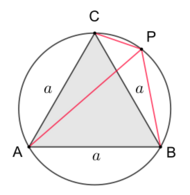Van Schooten's theorem
From HandWiki
Short description: On lines connecting the vertices of an equilateral triangle to a point on its circumcircle
Van Schooten's theorem, named after the Dutch mathematician Frans van Schooten, describes a property of equilateral triangles. It states:
- For an equilateral triangle [math]\displaystyle{ \triangle ABC }[/math] with a point [math]\displaystyle{ P }[/math] on its circumcircle the length of longest of the three line segments [math]\displaystyle{ PA, PB, PC }[/math] connecting [math]\displaystyle{ P }[/math] with the vertices of the triangle equals the sum of the lengths of the other two.
The theorem is a consequence of Ptolemy's theorem for concyclic quadrilaterals. Let [math]\displaystyle{ a }[/math] be the side length of the equilateral triangle [math]\displaystyle{ \triangle ABC }[/math] and [math]\displaystyle{ PA }[/math] the longest line segment. The triangle's vertices together with [math]\displaystyle{ P }[/math] form a concyclic quadrilateral and hence Ptolemy's theorem yields:
- [math]\displaystyle{ \begin{align} & |BC| \cdot |PA| =|AC| \cdot |PB| + |AB| \cdot |PC| \\[6pt] \Longleftrightarrow & a \cdot |PA| =a \cdot |PB| + a \cdot |PC| \end{align} }[/math]
Dividing the last equation by [math]\displaystyle{ a }[/math] delivers Van Schooten's theorem.
References
- Claudi Alsina, Roger B. Nelsen: Charming Proofs: A Journey Into Elegant Mathematics. MAA, 2010, ISBN:9780883853481, pp. 102–103
- Doug French: Teaching and Learning Geometry. Bloomsbury Publishing, 2004, ISBN:9780826434173 , pp. 62–64
- Raymond Viglione: Proof Without Words: van Schooten′s Theorem. Mathematics Magazine, Vol. 89, No. 2 (April 2016), p. 132
- Jozsef Sandor: On the Geometry of Equilateral Triangles. Forum Geometricorum, Volume 5 (2005), pp. 107–117
External links
- Van Schooten's theorem at cut-the-knot.org
 |


